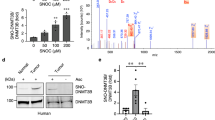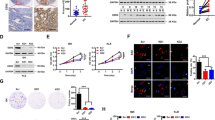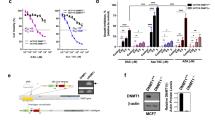Abstract
The mechanisms underlying the progression of noninvasive serous borderline ovarian tumors (SBOT) to low-grade invasive carcinomas are poorly understood. We recently showed that inhibition of p53 induces SBOT invasion by activating the PI3K/Akt pathway and transcriptionally repressing E-cadherin. In human cancers, aberrant DNA methylation is a common phenomenon, and it is thought to be involved in the progression from noninvasive to invasive ovarian carcinomas. In this study, we tested the hypothesis that inhibition of p53 downregulates E-cadherin by regulating the methylation of its promoter in SBOT cells. Here, we show that DNA methyltransferase-1 (DNMT1), but not DNMT3a or DNMT3b, was increased in SV40 LT-infected SBOT4 cells, SBOT4-LT and the low-grade invasive serous ovarian carcinoma-derived cell line MPSC1. Treatment with 5-Aza-dC, a DNMT1 inhibitor, restored E-cadherin promoter methylation and expression, and inhibited cell invasion in both invasive SBOT4-LT and MPSC1 cells. Moreover, knockdown of endogenous p53 using siRNA in SBOT3.1 cells induced DNMT1 expression and led to an increase in E-cadherin promoter methylation. Additionally, activation of the PI3K/Akt pathway is required for p53 inhibition-induced DNMT1 expression. The increase in DNMT1 was associated with the inhibition of p53-induced downregulation of E-cadherin and cell invasion. Our findings show an important role for p53 in the progression of SBOT to an invasive carcinoma, and suggest that downregulation of E-cadherin by DNMT1-mediated promoter methylation contributes to this process.
This is a preview of subscription content, access via your institution
Access options
Subscribe to this journal
Receive 50 print issues and online access
$259.00 per year
only $5.18 per issue
Buy this article
- Purchase on SpringerLink
- Instant access to full article PDF
Prices may be subject to local taxes which are calculated during checkout









Similar content being viewed by others
References
Ahluwalia A, Hurteau JA, Bigsby RM, Nephew KP . (2001). DNA methylation in ovarian cancer. II. Expression of DNA methyltransferases in ovarian cancer cell lines and normal ovarian epithelial cells. Gynecol Oncol 82: 299–304.
Asadollahi R, Hyde CA, Zhong XY . (2010). Epigenetics of ovarian cancer: from the lab to the clinic. Gynecol Oncol 118: 81–87.
Astanehe A, Arenillas D, Wasserman WW, Leung PC, Dunn SE, Davies BR et al. (2008). Mechanisms underlying p53 regulation of PIK3CA transcription in ovarian surface epithelium and in ovarian cancer. J Cell Sci 121: 664–674.
Balch C, Fang F, Matei DE, Huang TH, Nephew KP . (2009). Minireview: epigenetic changes in ovarian cancer. Endocrinology 150: 4003–4011.
Benton G, Crooke E, George J . (2009). Laminin-1 induces E-cadherin expression in 3-dimensional cultured breast cancer cells by inhibiting DNA methyltransferase 1 and reversing promoter methylation status. FASEB J 23: 3884–3895.
Bestor TH . (2000). The DNA methyltransferases of mammals. Hum Mol Genet 9: 2395–2402.
Bird AP . (1980). DNA methylation and the frequency of CpG in animal DNA. Nucleic Acids Res 8: 1499–1504.
Bonome T, Lee JY, Park DC, Radonovich M, Pise-Masison C, Brady J et al. (2005). Expression profiling of serous low malignant potential, low-grade, and high-grade tumors of the ovary. Cancer Res 65: 10602–10612.
Cavallaro U, Christofori G . (2004). Cell adhesion and signalling by cadherins and Ig-CAMs in cancer. Nat Rev Cancer 4: 118–132.
Cheng JC, Auersperg N, Leung PC . (2011). Inhibition of p53 induces invasion of serous borderline ovarian tumor cells by accentuating PI3K/Akt-mediated suppression of E-cadherin. Oncogene 30: 1020–1031.
Cheng P, Schmutte C, Cofer KF, Felix JC, Yu MC, Dubeau L . (1997). Alterations in DNA methylation are early, but not initial, events in ovarian tumorigenesis. Br J Cancer 75: 396–402.
Christofori G, Semb H . (1999). The role of the cell-adhesion molecule E-cadherin as a tumour-suppressor gene. Trends Biochem Sci 24: 73–76.
Darai E, Scoazec JY, Walker-Combrouze F, Mlika-Cabanne N, Feldmann G, Madelenat P et al. (1997). Expression of cadherins in benign, borderline, and malignant ovarian epithelial tumors: a clinicopathologic study of 60 cases. Hum Pathol 28: 922–928.
Fan H, Zhao Z, Quan Y, Xu J, Zhang J, Xie W . (2007). DNA methyltransferase 1 knockdown induces silenced CDH1 gene reexpression by demethylation of methylated CpG in hepatocellular carcinoma cell line SMMC-7721. Eur J Gastroenterol Hepatol 19: 952–961.
Fresno Vara JA, Casado E, de Castro J, Cejas P, Belda-Iniesta C, Gonzalez-Baron M . (2004). PI3K/Akt signalling pathway and cancer. Cancer Treat Rev 30: 193–204.
Gershenson DM, Silva EG, Tortolero-Luna G, Levenback C, Morris M, Tornos C . (1998). Serous borderline tumors of the ovary with noninvasive peritoneal implants. Cancer 83: 2157–2163.
Graff JR, Herman JG, Lapidus RG, Chopra H, Xu R, Jarrard DF et al. (1995). E-cadherin expression is silenced by DNA hypermethylation in human breast and prostate carcinomas. Cancer Res 55: 5195–5199.
Graff JR, Herman JG, Myohanen S, Baylin SB, Vertino PM . (1997). Mapping patterns of CpG island methylation in normal and neoplastic cells implicates both upstream and downstream regions in de novo methylation. J Biol Chem 272: 22322–22329.
Grille SJ, Bellacosa A, Upson J, Klein-Szanto AJ, van Roy F, Lee-Kwon W et al. (2003). The protein kinase Akt induces epithelial mesenchymal transition and promotes enhanced motility and invasiveness of squamous cell carcinoma lines. Cancer Res 63: 2172–2178.
Herman JG, Graff JR, Myohanen S, Nelkin BD, Baylin SB . (1996). Methylation-specific PCR: a novel PCR assay for methylation status of CpG islands. Proc Natl Acad Sci USA 93: 9821–9826.
Hudson LG, Zeineldin R, Stack MS . (2008). Phenotypic plasticity of neoplastic ovarian epithelium: unique cadherin profiles in tumor progression. Clin Exp Metastasis 25: 643–655.
Jones PA, Baylin SB . (2002). The fundamental role of epigenetic events in cancer. Nat Rev Genet 3: 415–428.
Laird PW, Jackson-Grusby L, Fazeli A, Dickinson SL, Jung WE, Li E et al. (1995). Suppression of intestinal neoplasia by DNA hypomethylation. Cell 81: 197–205.
Larue L, Bellacosa A . (2005). Epithelial–mesenchymal transition in development and cancer: role of phosphatidylinositol 3′ kinase/AKT pathways. Oncogene 24: 7443–7454.
Lee JM, Dedhar S, Kalluri R, Thompson EW . (2006). The epithelial–mesenchymal transition: new insights in signaling, development, and disease. J Cell Biol 172: 973–981.
Lee JO, Kwun HJ, Jung JK, Choi KH, Min DS, Jang KL . (2005). Hepatitis B virus X protein represses E-cadherin expression via activation of DNA methyltransferase 1. Oncogene 24: 6617–6625.
Leonhardt H, Page AW, Weier HU, Bestor TH . (1992). A targeting sequence directs DNA methyltransferase to sites of DNA replication in mammalian nuclei. Cell 71: 865–873.
Leu YW, Rahmatpanah F, Shi H, Wei SH, Liu JC, Yan PS et al. (2003). Double RNA interference of DNMT3b and DNMT1 enhances DNA demethylation and gene reactivation. Cancer Res 63: 6110–6115.
MacLeod AR, Szyf M . (1995). Expression of antisense to DNA methyltransferase mRNA induces DNA demethylation and inhibits tumorigenesis. J Biol Chem 270: 8037–8043.
Makarla PB, Saboorian MH, Ashfaq R, Toyooka KO, Toyooka S, Minna JD et al. (2005). Promoter hypermethylation profile of ovarian epithelial neoplasms. Clin Cancer Res 11: 5365–5369.
Okano M, Bell DW, Haber DA, Li E . (1999). DNA methyltransferases Dnmt3a and Dnmt3b are essential for de novo methylation and mammalian development. Cell 99: 247–257.
Pecina-Slaus N . (2003). Tumor suppressor gene E-cadherin and its role in normal and malignant cells. Cancer Cell Int 3: 17.
Peterson EJ, Bogler O, Taylor SM . (2003). p53-mediated repression of DNA methyltransferase 1 expression by specific DNA binding. Cancer Res 63: 6579–6582.
Pohl G, Ho CL, Kurman RJ, Bristow R, Wang TL, Shih Ie M . (2005). Inactivation of the mitogen-activated protein kinase pathway as a potential target-based therapy in ovarian serous tumors with KRAS or BRAF mutations. Cancer Res 65: 1994–2000.
Rahnama F, Shafiei F, Gluckman PD, Mitchell MD, Lobie PE . (2006). Epigenetic regulation of human trophoblastic cell migration and invasion. Endocrinology 147: 5275–5283.
Rahnama F, Thompson B, Steiner M, Shafiei F, Lobie PE, Mitchell MD . (2009). Epigenetic regulation of E-cadherin controls endometrial receptivity. Endocrinology 150: 1466–1472.
Ramchandani S, MacLeod AR, Pinard M, von Hofe E, Szyf M . (1997). Inhibition of tumorigenesis by a cytosine-DNA, methyltransferase, antisense oligodeoxynucleotide. Proc Natl Acad Sci USA 94: 684–689.
Risinger JI, Berchuck A, Kohler MF, Boyd J . (1994). Mutations of the E-cadherin gene in human gynecologic cancers. Nat Genet 7: 98–102.
Robertson KD, Uzvolgyi E, Liang G, Talmadge C, Sumegi J, Gonzales FA et al. (1999). The human DNA methyltransferases (DNMTs) 1, 3a and 3b: coordinate mRNA expression in normal tissues and overexpression in tumors. Nucleic Acids Res 27: 2291–2298.
Schuijer M, Berns EM . (2003). TP53 and ovarian cancer. Hum Mutat 21: 285–291.
Sheng S, Qiao M, Pardee AB . (2009). Metastasis and AKT activation. J Cell Physiol 218: 451–454.
Shieh YS, Shiah SG, Jeng HH, Lee HS, Wu CW, Chang LC . (2005). DNA methyltransferase 1 expression and promoter methylation of E-cadherin in mucoepidermoid carcinoma. Cancer 104: 1013–1021.
Shih Ie M, Kurman RJ . (2004). Ovarian tumorigenesis: a proposed model based on morphological and molecular genetic analysis. Am J Pathol 164: 1511–1518.
Singer G, Stohr R, Cope L, Dehari R, Hartmann A, Cao DF et al. (2005). Patterns of p53 mutations separate ovarian serous borderline tumors and low- and high-grade carcinomas and provide support for a new model of ovarian carcinogenesis: a mutational analysis with immunohistochemical correlation. Am J Surg Pathol 29: 218–224.
Sun L, Zhao H, Xu Z, Liu Q, Liang Y, Wang L et al. (2007). Phosphatidylinositol 3-kinase/protein kinase B pathway stabilizes DNA methyltransferase I protein and maintains DNA methylation. Cell Signal 19: 2255–2263.
Tam KF, Liu VW, Liu SS, Tsang PC, Cheung AN, Yip AM et al. (2007). Methylation profile in benign, borderline and malignant ovarian tumors. J Cancer Res Clin Oncol 133: 331–341.
Van Aken E, De Wever O, Correia da Rocha AS, Mareel M . (2001). Defective E-cadherin/catenin complexes in human cancer. Virchows Arch 439: 725–751.
Veatch AL, Carson LF, Ramakrishnan S . (1994). Differential expression of the cell–cell adhesion molecule E-cadherin in ascites and solid human ovarian tumor cells. Int J Cancer 58: 393–399.
Vergara D, Tinelli A, Martignago R, Malvasi A, Chiuri VE, Leo G . (2010). Biomolecular pathogenesis of borderline ovarian tumors: focusing target discovery through proteogenomics. Curr Cancer Drug Targets 10: 107–116.
Vogelstein B, Lane D, Levine AJ . (2000). Surfing the p53 network. Nature 408: 307–310.
Woo MM, Salamanca CM, Minor A, Auersperg N . (2007). An improved assay to quantitate the invasiveness of cells in modified Boyden chambers. In vitro Cell Dev Biol Anim 43: 7–9.
Wu J, Issa JP, Herman J, Bassett Jr DE, Nelkin BD, Baylin SB . (1993). Expression of an exogenous eukaryotic DNA methyltransferase gene induces transformation of NIH 3T3 cells. Proc Natl Acad Sci USA 90: 8891–8895.
Yoshiura K, Kanai Y, Ochiai A, Shimoyama Y, Sugimura T, Hirohashi S . (1995). Silencing of the E-cadherin invasion-suppressor gene by CpG methylation in human carcinomas. Proc Natl Acad Sci USA 92: 7416–7419.
Acknowledgements
This work was supported by grants from the Canadian Institutes of Health Research to PCKL and National Cancer Institute of Canada with funds from the Canadian Cancer Society to NA. PCKL is the recipient of a Child & Family Research Institute Distinguished Investigator Award. JCC is the recipient of four year fellowships for PhD students from University of British Columbia.
Author information
Authors and Affiliations
Corresponding author
Ethics declarations
Competing interests
The authors declare no conflict of interest.
Additional information
Supplementary Information accompanies the paper on the Oncogene website
Supplementary information
Rights and permissions
About this article
Cite this article
Cheng, JC., Auersperg, N. & Leung, P. Inhibition of p53 represses E-cadherin expression by increasing DNA methyltransferase-1 and promoter methylation in serous borderline ovarian tumor cells. Oncogene 30, 3930–3942 (2011). https://doi.org/10.1038/onc.2011.117
Received:
Revised:
Accepted:
Published:
Issue date:
DOI: https://doi.org/10.1038/onc.2011.117
Keywords
This article is cited by
-
Histone methyltransferase MLL1 drives renal tubular cell apoptosis by p53-dependent repression of E-cadherin during cisplatin-induced acute kidney injury
Cell Death & Disease (2022)
-
Estradiol-mediated inhibition of DNMT1 decreases p53 expression to induce M2-macrophage polarization in lung cancer progression
Oncogenesis (2022)
-
Role of limonin in anticancer effects of Evodia rutaecarpa on ovarian cancer cells
BMC Complementary Medicine and Therapies (2020)
-
Influence of TP53 and CDH1 genes in hepatocellular cancer spheroid formation and culture: a model system to understand cancer cell growth mechanics
Cancer Cell International (2016)
-
CD40 ligand induces RIP1-dependent, necroptosis-like cell death in low-grade serous but not serous borderline ovarian tumor cells
Cell Death & Disease (2015)



